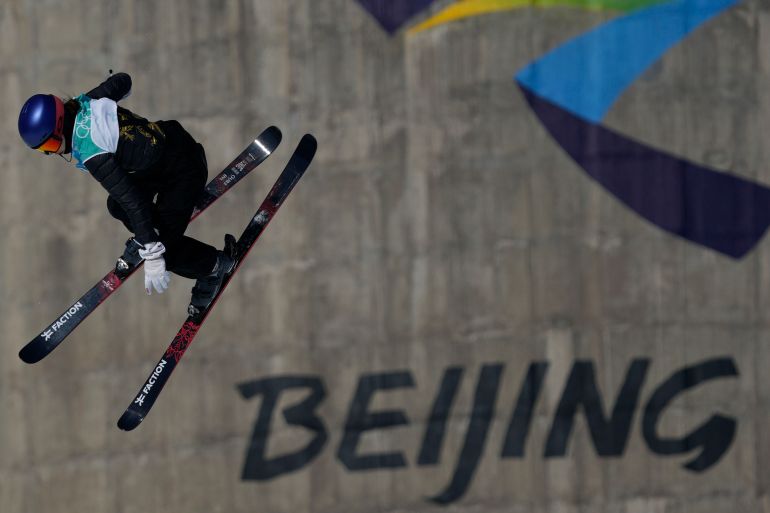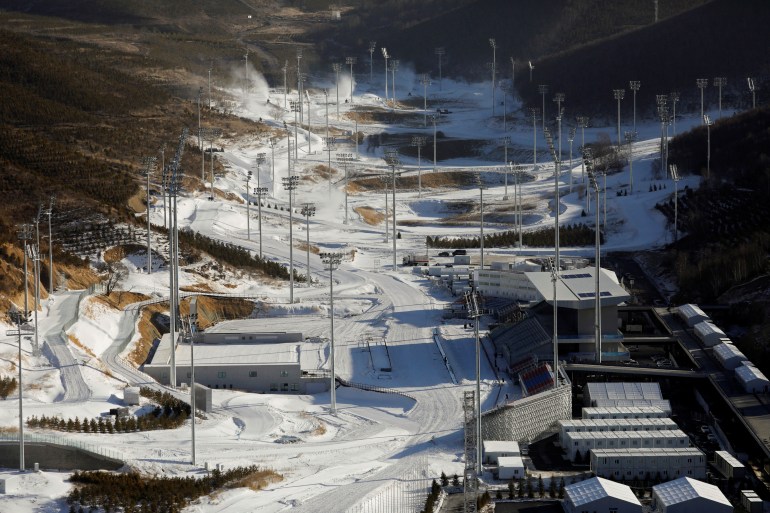Chinese hit the slopes as Eileen Gu fever takes hold
Industry analysts say China has work to do to ensure interest in winter sports is more than a passing fad.

Beijing, China – On February 8, the day US-born Chinese athlete Eileen Gu won her first Olympic gold medal in Beijing, sales of snowboards matching Gu’s style went through the roof.
On Alibaba’s Tmall app alone, purchases soared 450 percent compared with the previous day.
Keep reading
list of 4 itemsAhmaud Arbery’s killers repeatedly used racial slurs, court hears
Japan’s exports grow less than expected as trade deficit soars
Australia and UK deepen security ties amid China worries
“Everybody was talking about Eileen Gu when waiting in line at the skiing venue,” Zhang Pei, a skiing enthusiast and mother of a two-year-old in central China’s Shaanxi Province posted on the Chinese social media app WeChat.
The Internet buzz has translated into people taking to the slopes in droves.
More than one week into the 2022 Winter Olympics in Beijing, the Xishan Mountain Skiing Venue located just an hour’s drive from the capital was packed with parents bringing their toddlers for their first skiing experience.
Hundreds of people queued in a line into the resort stretching more than 1,000 metres.
Among them was Beijing resident Amy Hao, who recently started taking her toddler daughter on ski trips as a result of the Winter Games fever in China.
“My three-year-old has become very excited about skiing around this time [of the Olympics]. Since her first ski, it’s been a little out of control. She doesn’t want to leave the slope,” Hao told Al Jazeera.

Chatter about skiing across China’s social media platforms spiked 700 percent in February compared with the same period last year, according to 65db China, a social media monitoring firm. The hashtag #BeijingWinterOlympics featured in about 40 percent of the online discussion.
Industry observers, however, say that the majority of skiers in China are one-time participants unlikely to return to the slopes.
“Skiing is often consumed as a kind of entertainment product rather than a sport that requires repeated practice,” Laurent Vanat, a Switzerland-based skiing business expert, told Al Jazeera. “For the time being, ski areas in China are considered more as ski playgrounds than as mountain resorts, and one-time skiers account for a considerable portion of skier visits.”
Since its successful Winter Olympics bid in 2015, Beijing has issued a handful of guiding policies and development strategies to encourage the development of winter sports nationwide. In January, China’s National Bureau of Statistics announced the country had reached the goal of encouraging 300 million Chinese to participate in winter sports.
“The definition of what this 300 million refers to seems to have changed every week since China won the bid in 2015 and continues,” Mark Dreyer, a Beijing-based China sports analyst and author of Sporting Superpower: An Insider’s View on China’s Quest to Be the Best, told Al Jazeera. “The 300 million figure is incredibly vague and is symbolic at its best.”
While Beijing’s ambitious goals have raised eyebrows, analysts have also noted genuine growth in winter sports leading up to the Winter Games.
According to the 2020 China Ski Industry White Paper, the 2020/2021 snow season recorded 20.76 million ski visits — almost doubling the number from the previous season. By 2025, China is estimated to hit 50 million ski visits, which would make China the largest skiing nation in the world, overtaking the US, Dreyer said.
Now the world’s second-largest economy, China has a large and growing middle class with disposable income and time to pursue recreation and leisure. Since the emergence of the COVID-19 pandemic, Chinese that might have travelled overseas have been sealed off from the outside world under the country’s zero-infection policy, forcing them to explore leisure options at home.
“One of the big trends we were seeing prior to COVID was outbound travel from Chinese and outbound travel plus sports,” Dreyer said. “So these tourists have been forced to stay domestic and explore China’s own skiing resorts.”
Matthieu Mellul, director of 65dB China, told Al Jazeera that the Olympics and Eileen Gu, in particular, has “clearly played a booster role” for winter sports in China.
Mellul said the growing interest combined with government support meant winter sports has the potential to become popular among young and upper-middle-class families.
‘Poorly equipped’
China has about 770 ski venues nationwide, although only about 25 are up to Western standards, with accommodation and facilities associated with quality ski resorts, according to Vanat, the Swiss consultant.
“Most are still poorly equipped and are rather ski fields for beginners, only equipped with one or a few magic carpets,” he said.
Among an estimated 13 million Chinese skiers, beginners who have skied only once account for 80 percent of participants, while the percentage of beginners in the US and Europe is generally 20 percent or less, Vanat said.
“It’s a big challenge because if the beginners don’t have a good experience at a ski resort, they may never come back,” said Vanat.
Beijing mother Hao, who is an experienced skier, told Al Jazeera that this winter, all the venues near Beijing have been packed during the day.
“All [children’s] training camps have been filled up,” said Hao, who had no choice but to ski during evening sessions. “It’s not ideal, but at noontime, it’s nearly impossible for us [to ski] because there are just too many people on the slope.”
Mark Thomas, managing director of S2M Consulting, a China-focused sports marketing company, told Al Jazeera that China would have to do more than just build venues and infrastructure to generate lasting interest in winter sports.
“China is very good at building [venues] and getting things done in terms of the actual hardware — the Chinese are the best in the world,” Thomas said. “But the software side of it is a legacy that really needs to be the focus.”
A cautionary tale is Thaiwoo Ski Resort, located a three-hour drive from Beijing in Chongli, where most of the Olympics’ skiing events are taking place. The resort suffered losses of 200 million CNY ($32m) between 2020 and 2021, according to local media. Wanlong, one of the country’s first and largest skiing resorts located in the same district, has had losses for 17 consecutive years since its opening in 2003.
Vanat said it was hard to predict whether the industry would find a secure footing.
“But it mostly depends on what measures are further taken by the government,” he said.
“Nothing happens overnight,” said Thomas of S2M Consulting. “I think this is something that China has learned, just like we can’t create a great Chinese football team overnight. It just takes time.”